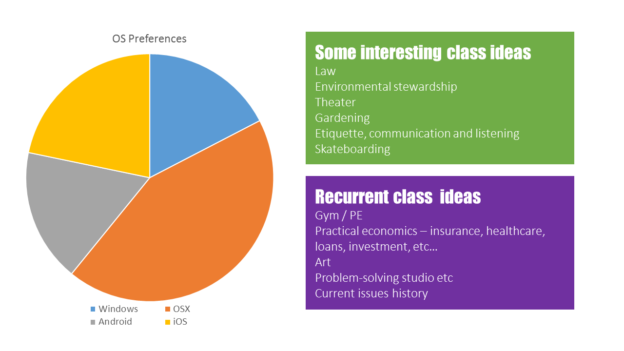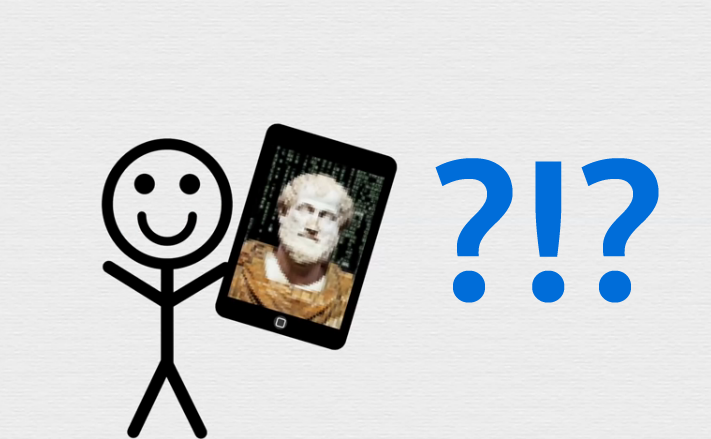Just some disorganized thoughts on this one. So we have this concept called STEM – Science, Technology, Engineering and Math education – where the US falls short according to many measures (though, interestingly, our national report card has yet to include engineering until recently). People invoke it as a kind of mandate frequently, and to what purpose matters quite a bit:
- If the question is should we be doing things like trying to get more socially excluded populations into engineering – I’d say absolutely yes. This has as much to do with how we broadly socialize women and people of color to participate in society as it does how they experience education (yes, this too is part of socialization, I realize).
- If the question is if we should emphasize STEM activities more in schooling – I’d say maybe. I wonder what STEM is in opposition to (or an advancement over).
Step 1
First off, what are we missing if we break it down by basic subjects?
The humanities, social sciences, languages and the arts.
Scratch that, we’ve got STEAM, advocates who take the position that design is what makes innovation in any STEM field possible – I’d agree on all accounts, except for say, math.
And, actually, there’s an interesting similarity between Art and Math – they both gain considerably more value when embedded in application. Math for Math’s sake is about as relevant or job-related as Art for Art’s sake, I think. Graphic design to communicate ideas or make interfaces more usable – or – statistics and predictive algorithms to make experiments possible or to solve problems – these seem to ring more true to innovation and “usefulness” for me.
Update: Er, scratch that too – according to the NSF “Science” here includes the social sciences. I think many people aren’t including these when they refer to STEM, however. Anyway, continuing…
So, generally, do I think we have too much emphasis on the social sciences, languages and humanities in schooling?
- Well, at the K-12 level I’m not sure we actually have any significant social science. I mean sure there’s geography and social studies (which is history, really) but generally I don’t see a lot of psychology, sociology, anthropology and political science in high school – and I think actually it would be great to have more of those. In high schools like mine the tests we were being taught for (ACT/SAT sure but also more importantly AP tests) didn’t include those, they included emphasis on base subjects like math or English.
- Languages, I think offer another similar dimension. Sure learning French or German is probably less useful and a sign of privilege or specialization. But you had better bet Spanish, Portuguese, Russian or Chinese would help you greatly in the future economy and job landscape.
- And then we land on the humanities. Generally I’d say that we teach the same American-centric history too many times and that English focuses far too much on making sense of written texts instead of the grand entourage of media we engage with today. These issues aren’t an unsolvable problem, though, we could just focus more on contemporary history and on cultural studies that think of “text” in a multimodal kind of way. And both of these areas help to emphasize important subset skills – perspective taking, critical inquiry and rhetoric – or the effective expression of ideas.
So, really, I’m not ready to say we should deemphasize them. I would, however, be ready to suggest that we replace Math class at the high school level with Engineering class – where advanced math would be taught but always in application to something – integrated into practice where possible.
Step 2
Second, what are these disciplines (or subjects) really about? I feel like we’d be better off to think about it in terms of literacies or skills. What kinds of competencies do we want our students to have coming out of an education system. STEM, to me, suggests the following:
- Science – Experimentation, causality and empiricism, internally consistent truth
- Technology – Well, for me this is digital literacy, and I’ll get to in a second
- Engineering – Problem-solving in an applied context, most often with physical objects or systems
- Math – Problem-solving and algorithms in an abstract context
So, really, I’d agree that we might not be focusing enough on some of these skills, but I’d also say that they’re not any more important than others that might be cultivated by the humanities and social sciences – critical and creative thinking, expression and perspective-taking and so on.
Digital literacy is hard to really reconcile in all of this – I see it as a composite of skills and perspectives – but on another level you could think about just pure competency in being able to manipulate tools as a fundamental. That is, everyone should know how to type, use a mouse and find information on the internet. In my dream world I’d rather say everyone should know how to question the black box, reverse engineer, remix, program, control a 3D interface, draw with a mouse, present stories on the internet and so much more. As you can see my categories already branch into any number of the skills and areas mentioned above.
Step 3
So, in other words what’s this really about?
I think it’s about an assumption of mapping schooling to jobs. We have great demand for jobs in STEM (and STEAM, really) but not so many in the humanities like history, English and cultural studies or social sciences like sociology, anthropology and political science. And, really, that wouldn’t be a problem if the humanities were like aviation or sculpture, where only a few people go in, make it out and land jobs, but instead we have situations like UIUC, where our highest enrollment major is Psychology (1150 students in 2013), but there is probably not that much demand for people in psychology-related careers. Similarly we have a rather high count of people in communications (742), political science (552), and animal sciences + vet med (applied but probably not that many jobs – 923). Engineering, science and business majors dominate the majority of enrollment, comparatively. The other “useless” majors aren’t actually as populated as you might expect – English (323), history (217), sociology (207), anthropology (126), global studies (195), recreation (163) and so on. Though you do see interesting things like 300 PhD’s in computer science or 90 PhD’s in English but that’s a different issue.
So, at the end of the day – I think I want to go back to just focusing on ways to integrate engineering and other practice/problem-solving based learning into all curriculum for kids and focusing on areas where we have inequalities, such as women enrolled in engineering, or, from a different perspective that’s important to me in particular, men (or extroverts or people of color!) in library science. 🙂







